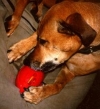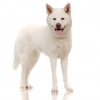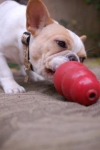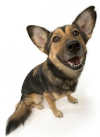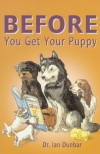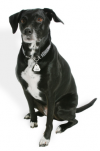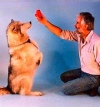Dog Star Daily® | Sun, 04/01/2007 - 12:35
Many years ago, I asked my malamute Phoenix, whether she wanted to drive down Solano Avenue to get some frozen yogurt and she didn't reply with her usual WrrrWrrrooooo and so, convinced she was up to some mischief, I quietly crept upstairs, only to find her puzzling with The Times crossword while listening to CNN. This may surprise some of you. It certainly surprised me. Normally I expect dogs to chew, dig and bark for amusement, not to read a book, enjoy needlepoint, or watch soaps on the television.
Dog Star Daily® | Sun, 04/01/2007 - 12:31
I believe the term “Retreat ’n Treat” was first coined by Suzanne Clothier. I initially called the technique “Retreat With Honor” after getting into a dodgy situation with an Akita. Basically, we were much too close and the situation was beginning to escalate — the Akita growled and I reprimanded. Both of us desperately wanted to normalize the interaction without losing face.
Dog Star Daily® | Sun, 04/01/2007 - 12:30
David LetterDog’s List of Things Dogs Cannot Do While Chewing a Chewtoy
Dog Star Daily® | Fri, 03/30/2007 - 14:21
Folks that have read my books and seen my videos know my sentiments about dog training: If you can’t train your dog while enjoying a cup of tea, reading a book, or watching television, then you’re doing something wrong.
I would regularly train my Malamute Phoenix while watching football (soccer) matches on the television. During the advertisement breaks, I would ask her to leave the couch and sit in her dog bed directly in front of the television. When she sat in her bed, I could barely see the bottom of the screen over the massive dome of her head. It was easy then to lie back on the couch, to take a sip of tea and to read a few pages while keeping just one eye on her solid sit stays. If at anytime, I could see the entire screen, I knew that she was sinking and that it was time to remind her of her Sit Stay.
Dog Star Daily® | Fri, 03/30/2007 - 14:19
David Letterdog's List of Things Dogs Cannot Do While Sitting
Dog Star Daily® | Fri, 03/30/2007 - 14:17
All owners hope that their young pup will develop into a happy-go-lucky, well behaved, good-natured adult dog that above all, lives to a fine old age. Without a doubt, appropriate puppy education is the single most important factor to ensure this outcome. The nature of the puppy's socialization and training depends very much on the changing physical and mental capabilities and constraints during the various stages ofpersonality development from birth to maturity.
Dog Star Daily® | Fri, 03/30/2007 - 00:09
This book is simply a MUST READ for anyone thinking of getting a puppy. Puppies should be raised in an errorless housetraining and chewtoy-training set-up. This is very easy to do and everything you need to know is described in this little book.
Dog Star Daily® | Wed, 03/28/2007 - 09:02
Congratulations on the new addition to your family! With a little work, some planning, and forethought, your new dog will be an effortless, well-behaved companion for years to come. It is important to recognize that first impressions are lasting ones and habits begin to develop from day one. Be sure to instill good manners and habits from the first day you bring your new puppy or dog home. Remember, good habits are as hard to break as bad ones. If you follow these simple guidelines, your dog’s transition into your home will be a piece of cake for both you and your new best friend.
Dog Star Daily® | Wed, 03/28/2007 - 08:49
Socialization is the process of becoming familiar with all kinds of animals, people, places, and things; as well as learning how to behave in society. All puppies need socialization regardless of breed, type, or temperament. Please do not take this for granted, regardless of your breed description. Even dogs from breeds that have a very good reputation for loving people will need to be thoroughly socialized as puppies, to make sure that they have lots of great experiences being around all kinds of different people. And more importantly, breeds that are known to be less social (often described as aloof) must be socialized to grow up to love to be around people in order to be good canine citizens (and not end up in news headlines).
Dog Star Daily® | Wed, 03/21/2007 - 16:23
In pet dog training, there is an endless quest for the quickest, easiest, most enjoyable and most expedient route to produce equipment-free and gizmo-free response reliability. The choice of training technique will have a huge influence on “time and trials to criterion.” As the quickest, and one of the simplest of all training techniques, lure/reward training is the technique of choice for most owners to teach their dog basic manners. For behavior modification and temperament training, food lure/reward training should be mandatory. There is extreme urgency to prevent and resolve behavior problems. Simple behavior problems, such as housesoiling, destructive chewing, and excessive barking, kill dogs. Time is of the essence. Similarly, biting, fighting, and fearful dogs are hardly happy, or safe to be around, and so there is simply no time to mess around with time-consuming techniques.
Pages

